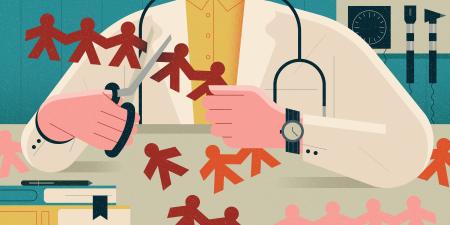Abstract
Although scientific literature about child abuse dates back to the 1850s, how society and medicine discussed and responded to this set of concerns changed dramatically in 1962. Since that time, the problem’s fuller scope has been revealed and reforms have been implemented.
Battered-Child Syndrome
Abuse of children has a long history, regardless of whether such abuse was publicly sanctioned or restricted to domestic, private spheres. Examples of abuse of children go back to biblical times,1 and laws dating from America’s colonial period acknowledge the need to remove some children from unsafe home environments.2 But 1962 is when our modern understanding of child abuse seemed to emerge,2,3 as it was the year that physician C. Henry Kempe and colleagues published their landmark article, which coined the term battered child syndrome, in the Journal of the American Medical Association (JAMA).4 This article reviews the influence of this turning point in the history of discussions and responses to child abuse in America.
Early Clinical Reports
In 1857, the French forensic physician Auguste Ambroise Tardieu began describing forms of child mistreatment we’d recognize today, including sexual abuse and child labor.5 He pointed out not only the prevalence of child abuse, but also how it could be diagnosed by a physician.6 His findings were roundly ignored by the medical establishment and society at large,6 and the topic doesn’t appear in the scientific literature again until 1929, when a Colombian physician, Jose Martinez, reidentified child abuse in clinical terms.7 Over the next 70 years, Martinez’s work continued to be generally ignored by medicine.7
Despite the emergence of nongovernmental child protection societies across America as early as 18752 and the codification of abusive child labor practices in the 1938 Fair Labor Standards Act,8 injuries to children were not documented in the US medical literature until 1946.9 That year, in the American Journal of Roentgenology, the pediatric radiologist John Caffey reported that though it was possible that the “chronic subdural hematomas in association with multiple fractures”6 that he observed were not injuries caused by abuse, they “appear[ed] to be of traumatic origin.”10
A 1955 JAMA article written by Paul V. Woolley and William A. Evans considered whether some childhood injuries could only be the result of repeated abuse. In their conclusion, they wrote: “It is difficult to avoid the over-all conclusion that skeletal lesions having the appearance of fractures—regardless of history for injury or the presence or absence of intracranial bleeding—are due to undesirable vectors of force.”11 The article makes euphemistic references to adults’ abusive behavior toward children in referring to “injury-prone environments,” which they describe as sites of “neurotic or frankly psychotic behavior on the part of at least one adult.”11 Between 1956 and 1962, “at least ten medical reports were published stating that children were being seen with inflicted injuries.”12
Policy Responses
Mandatory reporting. The appearance of “The Battered-Child Syndrome”4 in JAMA in 1962 finally provoked responses. In 1971, Kempe was quoted as saying: “I coined the term ‘The Battered Child Syndrome’ in 1962 despite its provocative and anger-producing nature. I had for the preceding 10 years talked about child abuse, non-accidental, or inflicted injury but few paid attention.”7 The roles of physicians in identifying abuse patterns were mentioned in Woolley and Evans’ 1955 article,11 but Kempe et al plainly asserted physicians’ unique responsibilities to diagnose, report, and prevent abuse of children. The same year that “The Battered-Child Syndrome” was published, Kempe attended a meeting of the US Children’s Bureau and recommended “passage of laws requiring doctors to report suspicions of abuse to police or child welfare,”2 the first four of which were enacted in 1963.2 By 1967, all states had reporting laws.2
Some physicians hesitant to report did not feel equipped to interpret a law that could hurt families or discourage adults from seeking medical help for a child.
In 1967, Vincent De Francis, an early leader along with Kempe, lamented: “No state and no community has developed a Child Protective Service program adequate in size to meet the service needs of all reported cases of child neglect, abuse and exploitation.”2 Even in 1973, US Senator Walter Mondale wrote: “Nowhere in the Federal Government could we find one official assigned full time to the prevention, identification and treatment of child abuse and neglect.”2 De Francis, Mondale, and many collaborators forged the passage of the Child Abuse Prevention and Treatment Act of 1974 (CAPTA),13 which authorized use of federal funds to improve states’ capacity to respond to physical abuse, neglect, and sexual abuse.
Echoing concerns of many physicians, the American Medical Association (AMA) House of Delegates in 1964 approved a position statement,14 which argued against placing the primary burden of protecting children on health professionals. Some physicians hesitant to report did not feel equipped to interpret a law that could hurt families or discourage adults from seeking medical help for a child.15 In the context of states’ passage of reporting laws, however, in 1965, the AMA supported legislation requiring physicians to report suspected abuse that mitigated their criminal or civil liability for reporting.16 In 1984, the AMA released guidelines for diagnosing child abuse.17
Diagnosis and prevention. By 1976, a new field devoted to child abuse and neglect had emerged, marked by the Journal of Home Economics urging development of regional and local child abuse detection, treatment, and prevention.18 By 1980, however, the number of cases reported exceeded 1 million,2 generating a vast foster care crisis. Alarmed, the US Congress passed the Adoption Assistance and Child Welfare Act of 1980,2 which required states to make “reasonable efforts”19 to avoid removing children from the custody of their birth parents. But by the 1990s, some argued that overreliance on family preservation also led to tragedy.2 Congress responded again by creating the Adoption and Safe Families Act of 1997, which prioritized children’s safety but did not abandon family preservation.2
Bias management. Racial bias in the handling of child abuse cases has dogged advocates for years.20 Efforts to promote community-based support for struggling parents have been complemented by amendments to CAPTA that, as the Child Welfare Information Gateway emphasized in 2017, enhance the “role[s] of communities in strengthening protective factors in a child’s environment and providing prevention services targeted toward different segments of the population.”3 But as child protection systems move from physician-led child abuse reporting to community-based strategies, some states, such as Texas, have taken actions that could compel physicians to report families of minors seeking gender-affirming care.21
Slow Progress
Even when the child protection system functions the way it is intended to do, nearly 3.5 million children are the subject of at least one child abuse referral each year.22,23 Physicians systematically underreport child abuse,24 and reporting was further hindered by the COVID-19 pandemic, as doctors and teachers—two of the most likely reporters of abuse—were unable to assess children in person.25 Nevertheless, the fact that “substantiated physical abuse … declined 52% from 1992 to 2007; [and] substantiated sexual abuse … declined 53% in the same period”26 signals that physician-researchers and activists’ efforts to push child abuse into public view over time has motivated progress.
References
- Gallagher BD. A brief legal history of institutionalized child abuse. Boston College Third World Law J. 1997;17(1):1-30.
- Myers JEB. A short history of child protection in America. Fam Law Q. 2008;42(3):449-463.
-
Child Welfare Information Gateway. Child maltreatment prevention: past, present, and future. Children’s Bureau, US Department of Health and Human Services; 2017. Accessed March 20, 2022. https://www.childwelfare.gov/pubPDFs/cm_prevention.pdf
- Kempe CH, Silverman FN, Steele BF, Droegemueller W, Silver HK. The battered-child syndrome. JAMA. 1962;181(1):17-24.
- Labbé J. Ambroise Tardieu: the man and his work on child maltreatment a century before Kempe. Child Abuse Negl. 2005;29(4):311-324.
-
Chadwick DL. The Child Abuse Doctors. STM Learning; 2011.
-
Krugman RD, Korbin JE, eds. C. Henry Kempe: A 50 Year Legacy to the Field of Child Abuse and Neglect. Springer Science + Business Media; 2013.
-
Donovan SA, Shimabukuro JO. The Fair Labor Standards Act (FLSA) child labor provisions. Congressional Research Service; 2016. Accessed September 6, 2022. https://sgp.fas.org/crs/misc/R44548.pdf
- Greeley CS. The evolution of the child maltreatment literature. Pediatrics. 2012;130(2):347-348.
- Caffey J. The classic: multiple fractures in the long bones of infants suffering from chronic subdural hematoma. Clin Orthop Relat Res. 2011;469(3):755-758.
- Woolley PV Jr, Evans WA Jr. Significance of skeletal lesions in infants resembling those of traumatic origin. J Am Med Assoc. 1955;158(7):539-543.
-
Fischer H. The sixtieth anniversary of the “battered child syndrome.” Hektoen Int J. 2022;14(1). Accessed October 12, 2022. https://hekint.org/2022/04/04/the-sixtieth-anniversary-of-the-battered-child-syndrome/
-
National Child Abuse and Neglect Training and Publications Project. The Child Abuse Prevention and Treatment Act: 40 Years of Safeguarding America’s Children. Children’s Bureau, US Department of Health and Human Services; 2014. Accessed March 21, 2022. https://www.acf.hhs.gov/sites/default/files/documents/cb/capta_40yrs.pdf
-
Council on Medical Service. AMA statement of position on protecting children against physical abuse. In: Proceedings of the House of Delegates. American Medical Association; 1964:112-113. Accessed October 12, 2022. https://ama.nmtvault.com/jsp/PsImageViewer.jsp?doc_id=1ee24daa-2768-4bff-b792-e4859988fe94%2Fama_arch%2FHOD00001%2F00000076
-
Sangoi L, Ronayne J, Shabazz B, Brico E. Your family or its health: intersections between the healthcare and foster care systems. Shriver Center on Poverty Law webinar. January 14, 2021. Accessed October 12, 2022. https://www.povertylaw.org/article/webinar-your-family-or-its-health/
-
Student American Medical Association. Remarks of J.P. Moss, president. In: Proceedings of the House of Delegates. American Medical Association; 1965:18-20. Accessed October 12, 2022. https://ama.nmtvault.com/jsp/PsImageViewer.jsp?doc_id=1ee24daa-2768-4bff-b792-e4859988fe94%2Fama_arch%2FHOD00001%2F00000079
-
Council on Scientific Affairs. AMA diagnostic treatment guidelines concerning child abuse and neglect: report I. In: Proceedings of the House of Delegates. American Medical Association; 1984:285-307. Accessed October 12, 2022. https://ama.nmtvault.com/jsp/PsImageViewer.jsp?doc_id=1ee24daa-2768-4bff-b792-e4859988fe94%2Fama_arch%2FHOD00001%2F00000119
- Schmidt R. What home economists should know about child abuse. J Home Econ. 1976;68(3):13-20.
-
Adoption Assistance and Child Welfare Act of 1980, Pub Law No. 96-272, 94 Stat 500 (1980).
- Lane WG, Rubin DM, Ragin M, et al. Racial differences in the evaluation of pediatric fractures for physical abuse. JAMA. 2002;288(13):1603-1609.
-
Dolan K. Texas is engaged in state-sanctioned child abuse. Newsweek. March 11, 2022. Accessed March 25, 2022. https://www.newsweek.com/texas-engaged-state-sanctioned-child-abuse-opinion-1687232
-
Children’s Bureau. Child Maltreatment 2019. US Department of Health and Human Services; 2021. Accessed September 1, 2022. https://www.acf.hhs.gov/sites/default/files/documents/cb/cm2019.pdf
-
Child Welfare Information Gateway. Child maltreatment 2019: summary of key findings. Children’s Bureau, US Department of Health and Human Services; 2021. Accessed September 6, 2022. https://www.childwelfare.gov/pubpdfs/canstats.pdf
- Flaherty EG, Sege R. Barriers to physician identification and reporting of child abuse. Pediatr Ann. 2005;34(5):349-356.
-
Teherani MF, Pickering LK. ED visits for child abuse drop during pandemic; hospitalizations increase. AAP News. March 1, 2021. Accessed December 7, 2022. https://publications.aap.org/aapnews/news/8933
- Bergman AB. Child protective services has outlived its usefulness. Arch Pediatr Adolesc Med. 2010;164(10):978-979.



